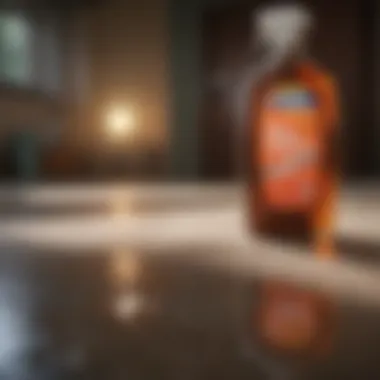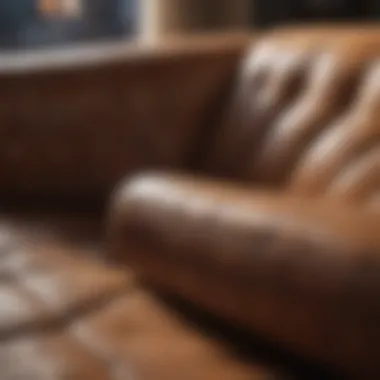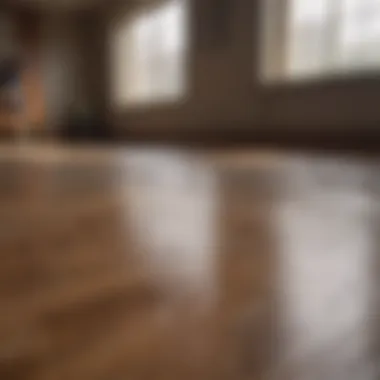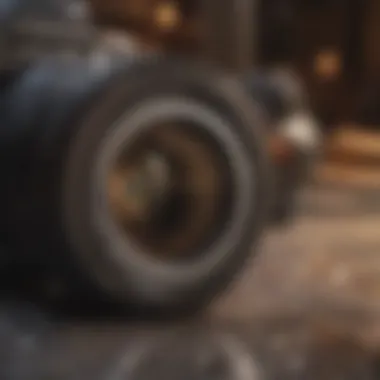Effective Strategies for Removing Urine Stains


Intro
Cleaning urine stains is an essential task for pet owners. Understanding how to effectively deal with these stains not only maintains the aesthetic of living spaces but also ensures a hygienic environment for both pets and humans. This article dives into the strategies for tackling urine stains, encompassing various surfaces and materials. Here, we will outline practical methods, recommend household items for cleaning, and discuss preventative measures to keep spaces clean and odor-free.
Pet Care Essentials
Taking care of pets goes beyond feeding them or taking them for walks. It involves creating a conducive environment that keeps the pet healthy and happy. When dealing with urine stains, pet owners should consider the following:
- Daily Nutrition Requirements: A well-fed pet is less likely to have issues. Proper nutrition promotes bladder health and reduces accidents.
- Exercise and Playtime: Regular physical activity can help regulate a pet’s behavior, which in turn can minimize accidents inside the house.
- Grooming Tips: Regular grooming helps in maintaining good hygiene. Pets with clean fur are less likely to spread odors around the house.
- Health and Wellness Check-ins: Routine vet visits ensure that pets are healthy. Monitoring their health can reduce instances of unforeseen accidents.
Understanding Urine Stains
Before exploring removal strategies, it’s important to understand the composition of urine stains. Urine contains urea, uric acid, ammonia, and various salts. These elements can bond to surfaces, making removal challenging if not addressed promptly.
"The longer a stain sits, the more difficult it becomes to remove. Immediate action is crucial."
Effective Cleaning Techniques
Cleaning urine stains requires a targeted approach based on materials:
For Fabric Surfaces
- Blot the Area: Use a clean cloth to absorb as much urine as possible. Avoid rubbing, as it may spread the stain.
- Use Vinegar Solution: Mix equal parts of white vinegar and water. Apply this to the stain and let it sit for 5-10 minutes.
- Rinse and Blot: Once the time is up, rinse the area with fresh water and blot again with a clean cloth.
For Upholstery
- Vacuum the Area: Remove any solid particles or debris around the stain.
- Apply Baking Soda: Generously sprinkle baking soda on the stain to absorb moisture and odors. Let it sit for a few hours.
- Use a Fabric Cleaner: Follow the instructions on a safe upholstery cleaner to treat the area and then blot dry.
For Flooring
- First, Absorb: For wood or tile, use absorbent towels to soak up any excess liquid.
- Create a Cleaning Paste: Combine baking soda with a bit of water to form a paste. Apply to the stain and let it dry.
- Mop with Odor Neutralizer: Finish by mopping the area with a product designed to remove odors.
Preventative Measures
Preventing urine stains can save a lot of trouble. Some effective strategies include:
- Regular Potty Breaks: Ensure your pet has frequent opportunities to relieve themselves outside.
- Training: Invest time in training your pet to understand where they can go and where they should not.
- Consider Puppy Pads: For young pets or those still in training, using puppy pads can help manage accidents in a designated area.
The End
Removing urine stains effectively requires knowledge of both the cleaning process and the factors that contribute to accidents. By understanding your pet’s needs and taking proactive measures, you can maintain a clean and pleasant home. For further reading, resources such as Wikipedia or Britannica can offer insights into animal care and cleaning methods.
Understanding Urine Stains
Understanding urine stains is crucial for pet owners and anyone who may encounter this common household challenge. Urine stains can not only mar the aesthetics of surfaces but can also lead to lingering odors and potential health risks. Identifying the chemistry of urine and understanding how it interacts with various materials is essential in choosing the right cleaning strategies. This section discusses the chemical properties of urine, why these stains occur, and the types of surfaces they typically affect.


Chemical Composition of Urine
Urine is a complex liquid consisting primarily of water, along with various organic and inorganic compounds. Its principal constituents include urea, creatinine, ammonia, uric acid, and salts. This composition makes urine a unique substance when it comes to staining properties.
When urine dries, uric acid can crystallize, making it challenging to remove completely. This crystallization is a key reason substances that are treated poorly or allowed to sit too long may have staining that is resistant to cleaning efforts. The older the stain, the stronger the bond with the surface. Therefore, understanding the chemical makeup of urine can help inform the appropriate cleaning techniques.
Why Stains Form
Urine stains typically arise when pets have accidents indoors. Factors leading to these accidents include behavioral issues, medical conditions, and environmental stress. When accidents happen, urine is not just a liquid but a solution that seeps into fabrics and floors. The longer the urine remains on the surface, the deeper it penetrates, which increases staining complexity.
In some cases, pets may not fully eliminate their waste outside due to anxiety, territorial issues, or simply because they have not been properly trained. This creates recurring stains that can lead to further damage over time if not addressed promptly. Recognizing why stains occur can help in devising strategies to remove them effectively.
Common Surfaces Affected
Urine can stain a variety of surfaces within a home, creating different challenges for pet owners. The following are some commonly affected surfaces:
- Carpets and Rugs: Urine can easily penetrate the fibers and padding, leading to persistent odors and stains.
- Upholstered Furniture: The fabric may absorb urine, requiring careful cleaning to maintain appearance and prevent odor.
- Hardwood Floors: If left unattended, urine can warp and stain hardwood, compromising the integrity of the wood.
- Tile and Grout: These surfaces often trap urine in the grout lines, making stains more difficult to remove.
- Concrete Floors: Urine can seep into concrete, leading to stains that may require professional cleaning solutions.
Understanding which surfaces are commonly affected by urine stains can help owners plan more effectively for their cleaning needs.
Initial Response to Accidents
When dealing with urine stains, the significance of the initial response cannot be overstated. Quick and effective action minimizes the chance of permanent staining and odor. Responding promptly can stop the urine from spreading and soaking deeper into the material, whether it be fabric, carpet, or hard surfaces. Ignoring or delaying the clean-up can lead to more extensive damage, requiring more intense cleaning methods later on. Thus, understanding the right steps to take immediately after an accident is crucial for both successful stain removal and maintaining hygiene in your living space.
Immediate Clean-Up Steps
Taking immediate action is essential in managing urine accidents. Here are step-by-step recommendations to effectively handle the situation:
- Act Quickly: As soon as the accident is discovered, it is important to begin cleaning it up. The longer urine sits, the harder it can be to remove.
- Blot the Area: Use paper towels or an absorbent cloth to blot the urine stain. Press gently to absorb as much liquid as possible without rubbing, which can spread the stain.
- Use Cold Water: Rinse the area with cold water. This can help dilute the urine. Avoid using hot water, as heat may set the stain and odor.
- Apply Cleaning Solution: Once you’ve blotted and rinsed, apply a suitable cleaning solution—whether it's a commercial cleaner or a DIY mixture of vinegar and water.
- Continue Blotting: After applying the solution, continue to blot until the area is mostly dry.
Taking these steps rapidly increases the chances of successful stain removal, allowing more effective treatments to be applied later.
Assessing the Damage
After the initial clean-up steps, it is vital to assess how bad the damage is. This evaluation helps determine whether additional cleaning methods are necessary and which ones would be the most effective:
- Evaluate the Stained Area: Is the stain visible? What is the size? This will help identify if it is a surface-level issue or if deeper cleaning is required.
- Consider the Material: Different materials react differently to cleaning methods. For example, what works on a carpet may not be appropriate for a leather couch.
- Identify Odor: Odor can often accompany urine stains. Determine if there is an lingering smell after the initial cleaning. If odor remains, it may indicate the urine has penetrated deeper materials.
- Check for Residue: After the area dries, check for any visible residue. Any patches left must be addressed to prevent future staining and odors.
A thorough assessment aids in selecting the right strategies to remove remaining stains and odors and prevents issues from becoming more serious.
Household Cleaning Solutions
Household cleaning solutions play a crucial role in managing urine stains effectively. Pet owners, especially, face unique challenges when it comes to maintaining cleanliness in their homes. Understanding the correct household items that can tackle these stubborn stains can save time, resources, and effort while ensuring a hygienic environment.
Many commercial products can be harsh on surfaces and contain chemicals that pose health risks to pets and humans alike. Therefore, using accessible and environmentally friendly solutions becomes not only practical but also necessary. Utilizing common household items can lead to efficient cleaning and minimize the environmental impact.
In this section, we will explore three effective methods that leverage common household products. Each method has its own benefits and considerations, making them suitable for various situations and surfaces.


Baking Soda and Vinegar Method
The baking soda and vinegar method is a simple yet powerful technique for removing urine stains. Baking soda acts as a natural absorbent, effectively neutralizing odors, while vinegar has antimicrobial properties that aid in breaking down the stain.
- Preparation: First, you need to blot the area with paper towels to remove excess moisture.
- Application: Sprinkle baking soda liberally over the stain. This will help to absorb moisture and odors. After that, spray or pour vinegar over the baking soda.
- Reaction: You will notice a fizzing reaction. Let it sit for about 10-15 minutes. This allows the solution to penetrate the stain.
- Rinsing: After the reaction has settled, blot the area again with clean, damp towels. This will help remove both the residue and any remaining stain.
- Drying: Finally, allow the area to air dry completely. You should notice a significant reduction in both the stain and odor.
Using Enzymatic Cleaners
Enzymatic cleaners are specifically formulated to contain enzymes that break down the proteins found in urine. This makes them particularly effective for pet-related stains. Here are key aspects of using enzymatic cleaners:
- Choose Wisely: Select a product that is pet-friendly and specifically designed for urine stains.
- Read Instructions: Follow the manufacturer's instructions for application. Generally, you will spray or pour the cleaner onto the stain, ensuring it is thoroughly soaked.
- Time Matters: Allow the enzymatic cleaner to sit for the recommended amount of time, usually around 10-20 minutes. This enables the enzymes to work effectively on the stain.
- Blot and Rinse: After letting it sit, blot the area with a clean cloth and rinse it with water. Follow by drying the cleaned area.
DIY Citrus-Based Cleaners
Citrus-based cleaners offer an eco-friendly and aromatic alternative for urine stain removal, harnessing the natural acidity of citrus fruits to tackle odors and stains. Here’s how you can create and use a DIY citrus cleaner:
- Ingredients: Combine the zest or juice of citrus fruits such as lemons or oranges with water in a spray bottle.
- Application: Spray the mixture onto the stain generously. The acidity helps to break down the stain while leaving a pleasant scent.
- Soaking: Allow the mixture to sit for about 10-15 minutes, giving it time to penetrate the stain.
- Blotting: Use a clean cloth to blot the stained area thoroughly. Repeat as necessary until the stain is fully lifted.
- Final Rinse: Rinse with water and let to dry naturally.
Using household cleaning solutions can be a cost-effective and non-toxic way to manage pet stains.
Through understanding and implementing these household cleaning solutions, pet owners can maintain a cleaner, healthier living environment while dealing with the inevitable challenges of pet ownership.
Surface-Specific Techniques
Understanding the nuances of removing urine stains from various surfaces is crucial for maintaining a clean and hygienic home. Each type of material has distinct properties that can affect the cleaning process. By utilizing surface-specific techniques, pet owners can ensure effective stain removal while also preserving the integrity of their belongings. Employing the right approach minimizes residual odor and prevents long-term damage. This section discusses strategies tailored specifically for fabrics, hard floors, and carpets, highlighting unique considerations for each surface.
Cleaning Fabrics and Upholstery
Cleaning fabrics and upholstery requires a gentle yet effective approach. Act quickly to avoid permanent staining. Use a clean cloth to blot excess urine, ensuring you do not rub it in. For spot cleaning, consider a mixture of mild detergent and water. Test an inconspicuous area first to avoid discoloration. Using a sponge, dab the solution on the stain and rinse with water.
- Specialized fabrics may require specific care instructions. Always check the tag on your item.
- Enzymatic cleaners can be particularly effective, as they break down the ammonia and uric acid in urine. Follow the manufacturer’s instructions carefully.
- Avoid excessive moisture, which can lead to mold or mildew. Ensure upholstery dries thoroughly after cleaning.
"Prompt action not only tackles the stain but also reduces any lingering odor that could lead to repeated accidents."
Hard Floors: Tile and Laminate
Hard floors, including tile and laminate, are generally easier to clean than porous surfaces, but require a specific process for best results. Start by wiping up any liquid with a cloth or paper towel. A vinegar solution can be effective for disinfecting and deodorizing. Mix equal parts white vinegar and water, then use a mop or cloth to clean the affected area.
- Avoid abrasive materials, as they can scratch the finish of your floor.
- Consider commercial floor cleaners designed specifically for tiles and laminates if vinegar is not an option.
- Rinse with clean water to remove any residual cleaner and dry the area properly to prevent slipping.
Carpet Cleaning Strategies
Carpet requires a more intensive cleaning approach due to its absorbent nature. First, blot the area with a towel, absorbing as much liquid as possible without rubbing it deeper into the fibers. One effective method involves using a mixture of white vinegar and water, applied with a spray bottle. Allow the solution to sit for several minutes before blotting with a clean cloth.
- Carpet cleaning machines can provide deeper cleaning. Ensure you understand the machine’s instructions to avoid damaging your carpet.
- Baking soda can help combat lingering odors once the spot is clean. Sprinkle it on the area after drying, let sit for a few hours, and vacuum it up.
- For severe stains, consider professional cleaning services which can thoroughly treat your carpet with specialized equipment and solutions.
Advanced Cleaning Methods


Effective strategies for dealing with urine stains often culminate in advanced cleaning methods. This section is crucial because some stains require more than just surface cleaning to ensure complete removal. Advanced techniques can address deeply embedded odors and discoloration that typical cleaning can miss. Understanding these methods is essential for maintaining a clean environment, especially for pet owners who frequently face such challenges.
Deep Cleaning Techniques
Deep cleaning techniques come into play when regular cleaning fails to yield satisfactory results. These methods often employ specialized tools and supplies to reach deeper layers of fabric or flooring.
- Steam Cleaning: This method uses high-temperature steam to penetrate fabrics and surfaces. It can effectively loosen dirt, grime, and odors. When using steam cleaning, ensure the surface can withstand heat, as not all materials react favorably.
- Hot Water Extraction: This technique involves injecting hot water mixed with cleaning solution deep into carpets and then extracting it back out along with dirt and urine residues. Hot water extraction outlets often provide a more thorough cleaning than surface methods.
- Foam Cleaning: This is effective for upholstery cleaning. You apply a foam cleaner that penetrates the fabric, lifting stains and odors without soaking the material. It requires a good amount of scrubbing and then vacuuming the treated areas.
- Odor Neutralization: In tandem with deep cleaning, using products like activated charcoal or baking soda can absorb and neutralize odors. While they do not directly remove the stain, their function can help diminish lingering scents that may not be noticeable after initial cleaning.
Overall, deep cleaning techniques can profoundly rejuvenate surfaces and eliminate recurring odors.
Professional Cleaning Services
In some cases, hiring professional cleaning services may be necessary. These experts can bring advanced equipment and techniques that are not accessible to the average homeowner.
- Experience and Expertise: Professionals often have extensive training and background in tackling various types of stains effectively. They can identify the nature of the stain and the best method to remove it.
- Advanced Equipment: Many cleaning services use industrial-grade machines, such as commercial steam cleaners, that can achieve results beyond typical consumer products.
- Time-Saving and Convenience: Engaging professional services can save homeowners time and effort. The process is often faster since the teams have streams of work designed for effective outcomes.
- Satisfaction Guaranteed: Many companies offer satisfaction guarantees, ensuring that they will return if the results are not up to standard. This assurance can provide peace of mind to homeowners.
Prevention and Management
Training Pets to Avoid Accidents
Training pets to avoid accidents is a vital component of prevention. First, establishing a consistent routine for bathroom breaks is crucial. Pets thrive on schedules. Take your dog outside regularly, especially after meals, playtime, or naps. Using verbal commands can also aid in this training. As an owner, praise your pet when they go in the correct place. This positive reinforcement helps them understand what behavior is desired.
There are a few essential steps to consider when training:
- Frequent Bathroom Breaks: Young pets, in particular, may need to go out more often. Keep track of their habits.
- Monitor Behavior: Keep an eye on signs indicating your pet needs to go outside, such as sniffing or circling.
- Limit Indoor Space: When beginning training, restrict access to areas where accidents frequently happen, like carpets.
Sometimes accidents happen despite best efforts. In this case, respond calmly and clean the area thoroughly to avoid repeating the behavior.
Maintaining a Clean Environment
Maintaining a clean environment is equally significant in managing urine stains. Dogs and cats are attracted to their own scents, and if a spot remains unclean, your pet may return to it repeatedly. Here are effective strategies for maintaining cleanliness in your home:
- Regular Cleaning: Routine cleaning of floors and furniture can prevent buildup of odors. Make sure to use pet-safe cleaning products.
- Immediate Response: Clean up accidents immediately. The sooner you address a stain, the less likely it is to become permanent.
- Use Covers: Consider using protective covers on furniture and high-traffic areas that are prone to accidents.
Keeping a clean environment can ease the burden of dealing with stains later on. Use deodorizing sprays to remove lingering odors, enhancing the pet's living environment.
"A clean space not only deters behavior but also promotes a healthy atmosphere for both pets and humans."
Overall, preventing urine stains through effective management techniques can make a substantial difference. Focus on training, routine, and cleanliness to reduce the likelihood of accidents and ensure a more livable space.
Epilogue
Recap of Key Strategies
To summarize the key strategies we discussed:
- Immediate clean-up is crucial after an accident. Acting quickly helps to minimize the damage and makes stain removal more manageable.
- DIY solutions, including baking soda and vinegar, can be both effective and economical. These household items are readily available and safe for most surfaces.
- Enzymatic cleaners should be considered, particularly for their specific ability to break down the components of urine, which are often resistant to regular cleaning products.
- Recognizing the differences in surface materials is fundamental. Each type of material, whether fabric, upholstery, or flooring, requires tailored cleaning techniques.
- Deep cleaning and seeking professional help can be valuable when stains are particularly stubborn or when damage is extensive. Professionals have access to specialized equipment and cleaning agents that can achieve better results.
- Developing a preventive strategy for pets, alongside maintaining a clean environment, reduces the chances of future occurrences. Training pets and creating a schedule for regular cleaning can go a long way.
Final Thoughts on Upkeep
Maintaining a stain-free home goes beyond just addressing visible issues; it encompasses a mindset of prevention and regular upkeep. For pet owners, it is a balancing act that involves being proactive in cleaning while also dedicating time to train pets. This article has emphasized the significance of using appropriate cleaning methods and tools suited to various surfaces. An understanding of materials and cleaning substances is vital to ensuring not just short-term solutions, but long-term hygiene and comfort in one's home.
Taking the time to master these techniques can significantly enhance the quality of your living environment, ensuring both you and your pets can coexist comfortably. Remember, a clean home reflects care and responsibility, which are indispensable traits for pet owners.







